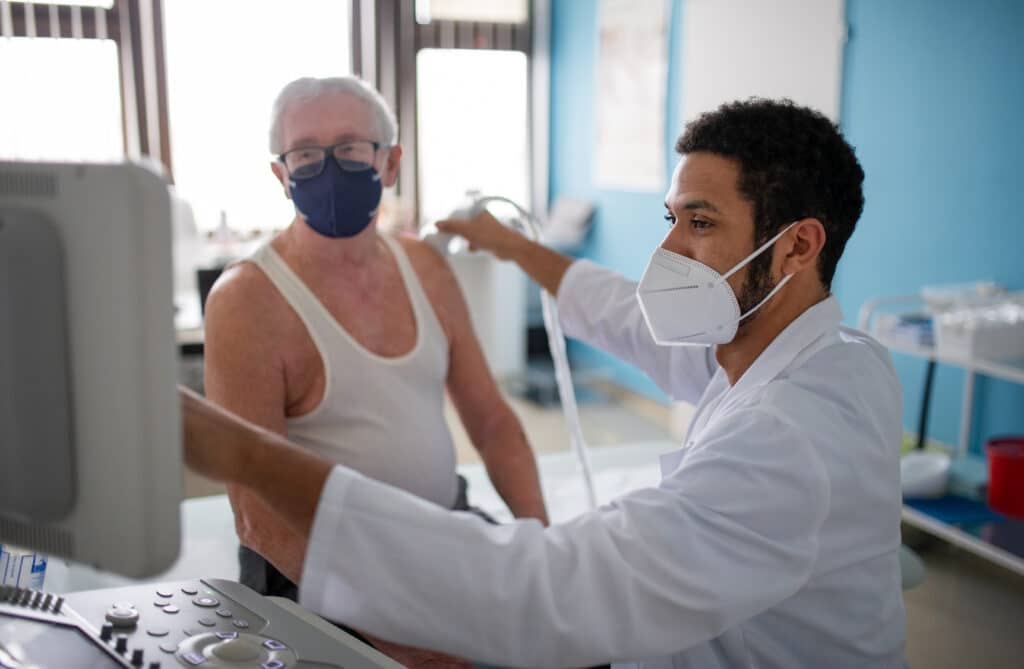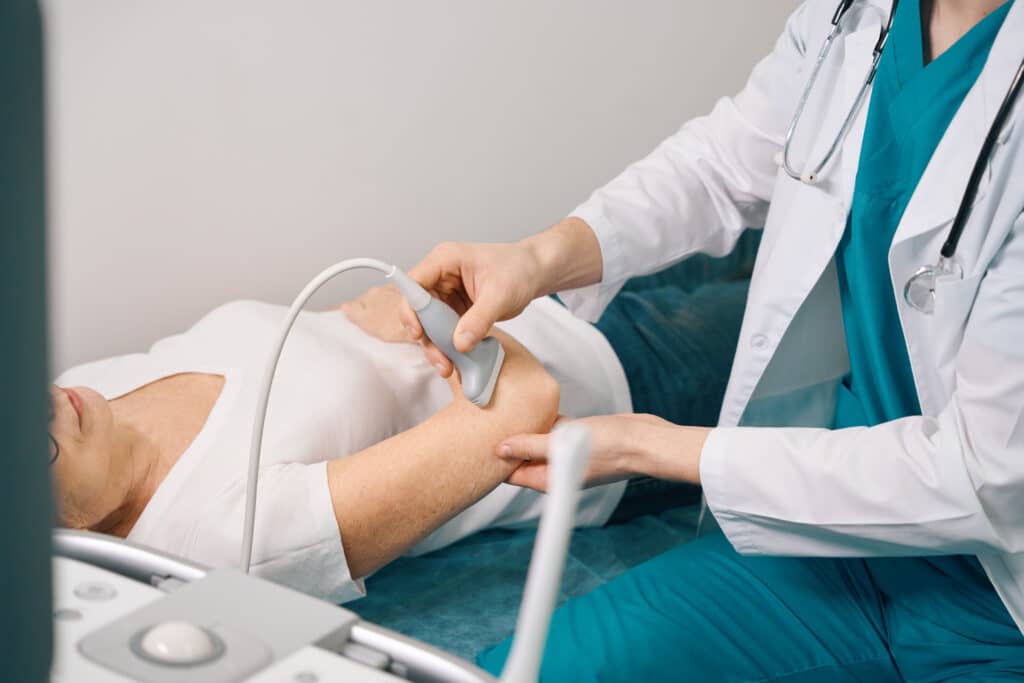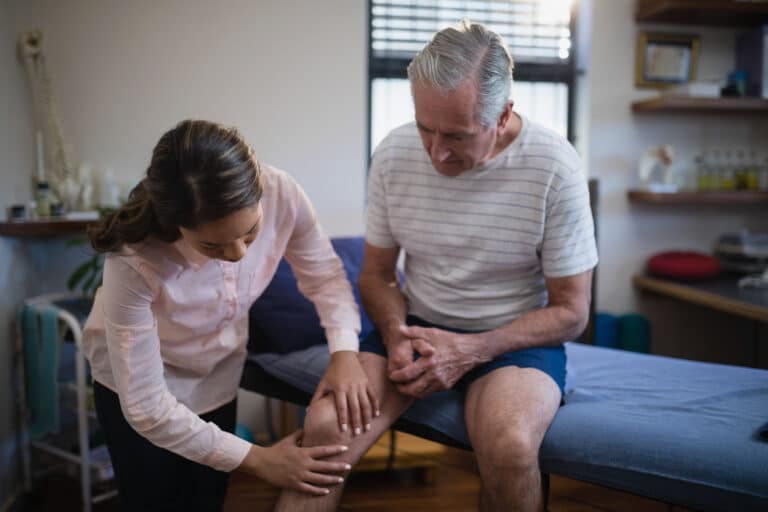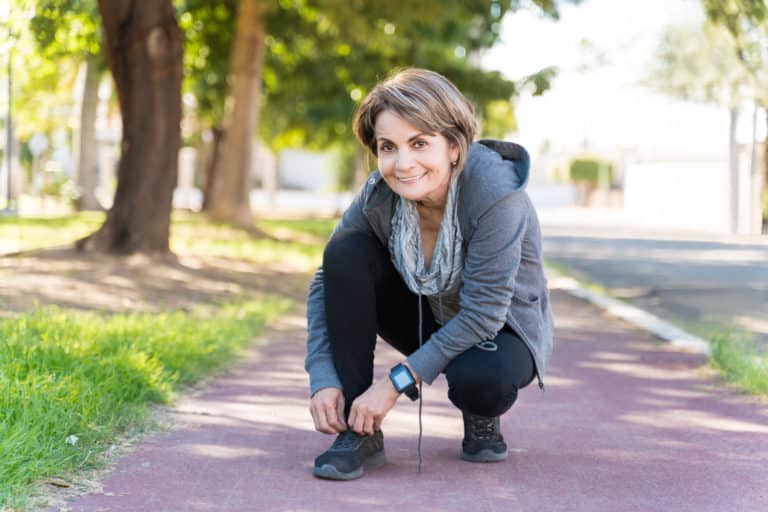Have you ever wondered if there’s a way to relieve your arthritis pain without taking medications or undergoing surgery? If so, you may be interested in learning about alternative treatment options like therapeutic ultrasound to manage your joint pain.
Physical therapists and other health professionals have used ultrasound to treat various musculoskeletal conditions, including arthritis, for decades. As a physical therapist with plenty of experience helping older adults manage joint pain, I’ve seen firsthand the benefits and downsides of therapeutic ultrasound.
In this article, I’ll share potential benefits, risks, effectiveness, and practical tips for therapeutic ultrasound for arthritis. Then, you can decide whether therapeutic ultrasound seems right for you and understand how to use it safely.
The Potential Benefits of Ultrasound
Arthritis is a common condition among older adults that causes joint pain, stiffness, swelling, and inflammation. There are many types of arthritis, such as osteoarthritis, rheumatoid arthritis, and psoriatic arthritis.
According to the Centers for Disease Control and Prevention (CDC), arthritis affects about 54.4 million adults in the United States, and about half are 65 or older.1
Arthritis can limit mobility and quality of life, making it hard to perform daily activities, exercise, and sleep well. The most common concerns I see with older adults with arthritis are joint pain and stiffness.
While there is no cure for arthritis, many conventional and alternative treatments, such as therapeutic ultrasound, can help you manage your symptoms more effectively.
Therapeutic ultrasound is a treatment that uses sound waves to create heat and vibration in the tissues affected by arthritis using an ultrasound machine with a console and a ‘sound head’ wand.
When the sound head is placed on the skin over the joint, sound waves are transmitted to the tissues for treatment. The waves used in this treatment can be targeted to different tissue depths depending on the frequency used. The higher the frequency, the shallower the penetration, and vice versa.
Thermal vs. Non-Thermal Effects
The sound waves can produce two main varieties of effects: thermal and non-thermal.
The friction of the sound waves with the molecules in the tissues causes a thermal effect, which generates heat. The heat helps to increase blood flow, reduce muscle spasms, relax tight tissues, and decrease pain or stiffness in a joint.
The vibration of the sound waves causes a non-thermal effect. This resembles a ‘micro-massage’ action within the tissues that stimulate cell repair. This vibration also contributes to reducing inflammation, swelling, and scar tissue formation in the joint.
Therapeutic ultrasound can help improve the function and mobility of the joints affected by arthritis through a combination of these effects. Some of the advertised benefits of therapeutic ultrasound for arthritis include:
- Reducing pain and discomfort in the joint
- Improving range of motion and flexibility in the joint
- Enhancing tissue healing and regeneration in the joint
- Decreasing joint stiffness and rigidity
- Preventing or delaying joint degeneration
In my experience with therapeutic ultrasound as a treatment for joint pain, results vary widely depending on the patient and their condition. However, this doesn’t mean that ultrasound isn’t effective.
There is some evidence that supports the benefits of therapeutic ultrasound for arthritis. For example, a recent study found that therapeutic ultrasound is a safe and effective treatment for reducing pain and improving joint function in knee osteoarthritis.2
Refer to your doctor for the most up-to-date and reliable research when deciding whether this or any other treatment suits your condition.
Risks and Limitations of Therapeutic Ultrasound
While therapeutic ultrasound may have some benefits for arthritis, it is not a miracle cure, and it may not work for everyone. In the interest of safety, let’s cover a few risks and limitations you should be aware of before deciding to use therapeutic ultrasound.
Injuries
One of the main risks of therapeutic ultrasound is that it can cause burns, skin irritation, or nerve damage when improperly applied.
In my experience, these risks are minimal when applied by a healthcare professional or an appropriately trained patient. To avoid these complications, you should always follow the instructions of your therapist or the device manufacturer and check your skin regularly for any signs of damage.
Complications from Other Conditions
Another risk of using therapeutic ultrasound is that it can interfere with some medical conditions or devices that you may have. For example, you should not use therapeutic ultrasound if you are pregnant, have a pacemaker, metal implants, an infection, or a tumor.
Therapeutic ultrasound is usually an adjunct to other treatments rather than a standalone therapy. This means you should not rely on therapeutic ultrasound alone to treat your arthritis but use it with other interventions such as medication, physical therapy, and exercise.
Having worked with many older adults to minimize joint pain, I have always seen better therapeutic ultrasound results combined with other treatments like exercise.
Effectiveness of Therapeutic Ultrasound for Arthritis
It’s worth discussing how practical therapeutic ultrasound is for arthritis and how it compares to other treatments.
Many factors may influence the effectiveness of therapeutic ultrasound, including the type and severity of arthritis. Other factors include the joint involved, the frequency, intensity, duration, mode, and number of ultrasound sessions, and each person’s individual response.
There is some evidence that therapeutic ultrasound can be effective for some types of arthritis and some joints, especially when used in combination with other treatments. However, there is also evidence that therapeutic ultrasound may have little or no effect on certain arthritis varieties and joints. Its effects may also be short-lived or inconsistent.
For example, a recent systematic review of 15 studies found that therapeutic ultrasound can reduce pain and improve function for people with chronic knee and shoulder pain. The review also found that, in some cases, ultrasound therapy was more effective than other treatments used in various studies.3
However, another review published in 2001 reviewed 35 studies and found little evidence that therapeutic ultrasound was more effective than a placebo for treating people with various forms of joint pain.4
Similar to my experience with therapeutic ultrasound in the clinic, the available research suggests that therapeutic ultrasound’s effectiveness is inconsistent. For this reason, it’s essential to consult your healthcare provider before using therapeutic ultrasound and follow their recommendations for proper use.
How to Use Therapeutic Ultrasound

If you’ve decided to try a therapeutic ultrasound session for your arthritis, consult your doctor or physical therapist first. They can help you determine if ultrasound suits your condition and advise you on the best approach to your treatment.
A trained professional in a clinic usually applies therapeutic ultrasound. However, some devices are available for home use by prescription or over-the-counter. If you decide to use ultrasound at home, always follow the instructions of your healthcare provider and the device manufacturer carefully.
A Step-by-Step Approach to Applying Ultrasound
Prepare the treatment area by cleaning and drying your skin. Remove any jewelry, clothing, or bandages that may interfere with the ultrasound waves.
First, apply a thin layer of ultrasound gel to your skin over the affected joint. This gel is required to transmit the sound waves into the tissues.
Next, turn on the ultrasound machine and select your desired settings.
Common settings to consider during setup:
- Frequency: The number of sound waves per second, measured in hertz (Hz). The frequency determines how deep the sound waves can penetrate into tissue. Higher frequencies (1–3 MHz) are used for superficial structures (for example, the joints of your hand), while lower frequencies (0.5–1 MHz) are used for deeper structures (for example, your hip joint).
- Intensity: The amount of power or energy the sound waves deliver, measured in watts per square centimeter (W/cm2). The intensity determines how much heat and vibration are generated in the tissues. Higher intensities (1–3 W/cm2) are for thermal effects, such as increasing blood flow and relaxing tight tissues. Lower intensities (0.1–0.5 W/cm2) are used for non-thermal effects, such as reducing inflammation and stimulating cell activity.
- Duration: The duration depends on the size of the treatment area and the other settings. Generally, smaller areas require less time, while larger areas require more time.
Place the sound head on your skin over the gel-covered area, then move the head slowly and continuously over the treatment area in a circular motion. Make sure not to stop moving the head, as this may cause burns or pain.
After treatment, turn the ultrasound machine off. Remove excess gel from your skin and clean the sound head with a cloth.
The frequency of treatment for therapeutic ultrasound varies depending on your condition and the preferences of your healthcare provider. In my experience with ultrasound, I recommend three sessions per week as a happy middle ground for most people’s needs.
Exercises to Complement Ultrasound for Arthritis
One way to enhance the effects of therapeutic ultrasound for arthritis is to pair it with exercise. With the right exercises, you can promote lubrication, circulation, and flexibility in your joints, which is an excellent complement to any passive treatment such as therapeutic ultrasound.
The best exercise for you will depend on your health history and the specifics of your arthritis, so it’s a good idea to speak with your physical therapist before starting any exercise program.
Exercises for Knee Arthritis
Start with gentle movements to mobilize your knee joints, such as heel slides and windshield wipers. You can also do stretches to loosen your hamstrings, quadriceps, and calves. I often recommend bodyweight movements such as squats and step-ups or resistance exercises such as seated knee extensions for strengthening exercises.
Exercises for Hip Arthritis
Again, start with gentle movements to mobilize your hip joints, such as hip circles, leg swings, and knee hugs. You can also do stretches to loosen your hip flexors, glutes, and groin. I recommend side-lying leg lifts, band walks, and lunges for strengthening exercises.
Exercises for Shoulder Arthritis
Once again, start with gentle movements to mobilize your shoulder joints, such as shoulder rolls, arm circles, and pendulum swings. Stretches to loosen your chest, back, and neck muscles may be helpful. For strengthening exercises, I often educate my patients on different movements to strengthen the rotator cuff and other supporting shoulder muscles.
Exercises for Arthritis of the Hand
Like other joints, focus on gentle movements to mobilize your hand joints, such as finger bends, thumb touches, and wrist circles. Keeping up on stretches for your finger and wrist muscles is also essential. Strengthening exercises such as putty or ball squeezes and resisted finger extensions help keep the muscles of your hand strong.
These are just some examples of exercises that you can do before or after using therapeutic ultrasound for arthritis. Remember to start slowly and gradually increase the intensity and duration of the exercises as you feel comfortable. Of course, you should also listen to your body and modify any activity that causes pain or discomfort.
Key Takeaways
Therapeutic ultrasound for arthritis can be a complicated topic, but a better understanding of how it works can help you decide whether or not to include it in your treatment plan. Here are some key points to remember about therapeutic ultrasound for arthritis:
- Therapeutic ultrasound is an alternative treatment option for managing arthritis pain.
- It uses sound waves to generate heat and vibration in tissues affected by arthritis.
- Benefits include reducing pain, improving flexibility, enhancing tissue healing, and preventing joint degeneration.
- Risks include potential burns, skin irritation, nerve damage, and interference with some medical conditions or devices.
- While some studies support its efficacy, results are inconsistent, and it’s best used as an adjunct to other treatments.
- Applying ultrasound involves specific steps, including using gel, adjusting frequency, intensity, and duration settings, and ensuring continuous movement of the device.
- Pairing therapeutic ultrasound with targeted exercises can enhance treatment effects.
- Always consult a healthcare professional before starting therapeutic ultrasound treatments.
References
- Center for Disease Control and Prevention: Arthritis-Related Statistics
- Draper, D.O., Klyve, D., Ortiz, R. et al. Effect of low-intensity long-duration ultrasound on the symptomatic relief of knee osteoarthritis: a randomized, placebo-controlled double-blind study. J Orthop Surg Res 13, 257 (2018). https://doi.org/10.1186/s13018-018-0965-0
- Rohit Aiyer, Selaiman A Noori, Ke-Vin Chang, Boyoun Jung, Abdullah Rasheed, Nitin Bansal, Einar Ottestad, Amitabh Gulati, Therapeutic Ultrasound for Chronic Pain Management in Joints: A Systematic Review, Pain Medicine, Volume 21, Issue 7, July 2020, Pages 1437–1448, https://doi.org/10.1093/pm/pnz102
- Valma J Robertson, Kerry G Baker, A Review of Therapeutic Ultrasound: Effectiveness Studies, Physical Therapy, Volume 81, Issue 7, 1 July 2001, Pages 1339–1350, https://doi.org/10.1093/ptj/81.7.1339






